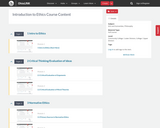
The Introduction to Ethics Course was developed through the Ohio Department of Higher Education OER Innovation Grant. This work was completed and the course was posted in September 2019. The course is part of the Ohio Transfer Assurance Guides and is also named OAH046. For more information about credit transfer between Ohio colleges and universities, please visit: www.ohiohighered.org/transfer.Team LeadNatalie Kertes-Weaver Ursuline CollegeContent ContributorsBenjamin Cordry Lorain County Community CollegeBrad Lipinski Cuyahoga Community CollegeToni Nicoletti Cleveland State UniversityLibrarianMandi Goodsett Cleveland State UniversityReview TeamTravis Hreno University of AkronRobert Loftis Lorain County Community College
- Subject:
- Arts and Humanities
- Philosophy
- Material Type:
- Full Course
- Provider:
- Ohio Open Ed Collaborative
- Date Added:
- 05/16/2019
